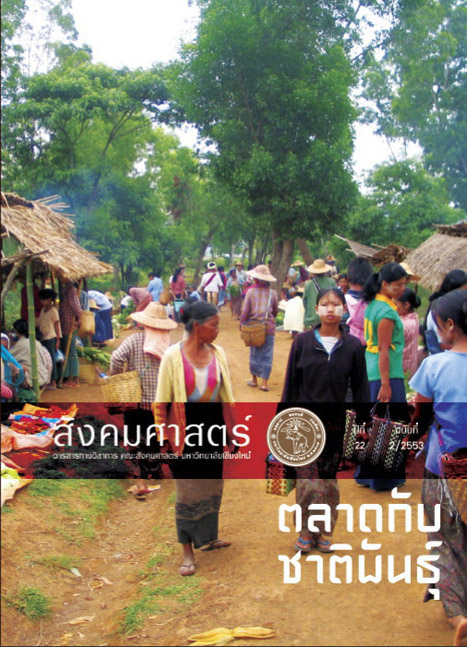From Market to the Street: the Journey of the Red Shirt Woman Traders
Main Article Content
Abstract
This article investigates the living, working, and family conditions that motivated women, as traders, to participate in the Red Shirt movement. Focusing on a group of women traders in Chiang Mai’s Sankamphaeng marketplace as a case study, the article highlights two sets of findings. First, the study found that engaging in the occupation of trader has provided an opportunity for women to have a greater role in the public sphere. As this career path requires a significant shift from more traditional roles related to family and household, it has also given women the freedom to travel and experience more cosmopolitan environments. Secondly, the study shows that the changing contexts and social dynamics of the Sankamphaeng marketplace resulted in a sense of community among traders; it was out of this community that the local Red Shirt movement, called “Sankamphaeng Ruk Prachatippatai (Samkamphaeng Love Democracy)” emerged. The article argues that the establishment of the local Red Shirt movement was shaped by the Thaksin government’s policy, which linked economic and political spheres together. It also illustrates the transformation of identity and awareness among women traders that resulted from their participation in the Red Shirt movement.
Article Details
All written articles published on Journal of Social Sciences is its author’s opinion which is not belonged to Faculty of Social Sciences, Chiang Mai University or is not in a responsibility of the journal’s editorial committee’s members.
References
นลินี ตันธุวนิตย์, สุไลพร ชลวิไล และ ศิริพร โคตะวินนท์. 2545. ประสบการณ์การต่อสู้ของชาวลุ่มน้ำมูล กรณีศึกษาเขื่อนปากมูลและเขื่อนราษีไศล. ใน ผาสุก พงษ์ไพจิตร และคณะ (บก.), วิถีชีวิต วิธีสู้ ขบวนการประชาชนร่วมสมัย, เชียงใหม่: สำนักพิมพ์ตรัสวิน.
ปณิธี สุขสมบูรณ์. 2545. เครือข่ายทางสังคมและการแสวงหาทางเลือกของแม่ค้าหาบเร่ แผงลอย: กรณีศึกษาแม่ค้าหาบเร่ แผงลอยชาวอีสานที่อาศัยอยู่ในชุมชนนางเลิ้ง. วิทยานิพนธ์มหาบัณฑิต สาขาสังคมวิทยา มหาวิทยาลัยธรรมศาสตร์.
ปรานี วงษ์เทศ. 2549. เพศสภาวะในสุวรรณภูมิ (อุษาคเนย์). กรุงเทพฯ: สำนักพิมพ์มติชน.
ปิ่นแก้ว เหลืองอร่ามศรี. 2552. “นิเวศและเพศภาวะ กับเสียงที่เงียบหายในสตรีนิยมและขบวนการสิ่งแวดล้อมไทย” ใน พริศรา แซ่ก้วย (บก.) วารสารจุดยืน ปีที่ 3: ศูนย์สตรีศึกษา คณะสังคมศาสตร์ มหาวิทยาลัยเชียงใหม่.
วารุณี ภูริสินสิทธิ์. 2543. “ความเป็นผู้หญิงในสังคมไทย”. วารสารสังคมศาสตร์ 12 (2), คณะสังคมศาสตร์ มหาวิทยาลัยเชียงใหม่: 134 – 160.
สมรักษ์ ชัยสิงห์กานานนท์. 2549. “บทนำ” ใน สมรักษ์ ชัยสิงห์กานานนท์ (บก.) ตลาดในชีวิต ชีวิตในตลาด. กรุงเทพฯ, ศูนย์มานุษยวิทยาสิรินธร: 1-17.
สุชาดา ทวีสิทธิ์ และเมธาวี นินนานนท์. 2552. “การเปลี่ยนแปลงของผู้หญิงแกนนำในกรณีคัดค้านเขื่อนลำโดมใหญ่ จังหวัดอุบลราชธานี” ใน พริศรา แซ่ก้วย (บก.) วารสารจุดยืน ปีที่ 3:ศูนย์สตรีศึกษา คณะสังคมศาสตร์ มหาวิทยาลัยเชียงใหม่.
สุนี ไชยรส. 2550. “เรื่องเล่าจากเฟมินิสต์ 14 ตุลา ‘กลุ่มผู้หญิงธรรมศาสตร์’” ใน พริศรา แซ่ก้วย(บก.) วารสารจุดยืน ปีที่ 1: ศูนย์สตรีศึกษา คณะสังคมศาสตร์ มหาวิทยาลัยเชียงใหม่.
อภิชาต สถิตนิรมัย. 2553. “เสื้อแดงคือใคร: ม็อบเติมเงิน ไพร่ หรือชนชั้นกลางใหม่กับทางแพร่งสังคมไทย” ใน Red Why: แดงทำไม. กรุงเทพฯ: สำนักพิมพ์โอเพ่นบุ๊กส์.
อภิชาต สถิตนิรามัย. 2554. จากไพร่ฟ้าสู่ความเป็นพลเมือง (From Subjects to Citizenship). www.prachatai.com/journal/2011/05/34527 1 พฤษภาคม 2554.
อริยา เศวตามร์. 2544. แม่ค้า: ปากปลาร้าหรือเทพธิดาของบ้าน. ศูนย์สตรีศึกษา คณะสังคมศาสตร์ มหาวิทยาลัยเชียงใหม่.
Bowie, Katherine. 2008. “Standing in the Shadows: Of matrilocality and the role of women in a village election in northern Thailand”. American Ethnologist 35 (1): 136-153.
Doneys, Philippe. 2002. Political Reform Through The Public Sphere: Women’s Groups And The Fabric of Governance. In Duncan McCargo (ed.) Reform Thai Politics. NIAS Press.
Keyes, Charles. 2010. “From Peasant to Cosmopolitan Villagers: Refiguring the ‘Rural’ in Northeastern Thailand” paper present in conference ‘Revisiting Agrarian Transformations in Southeast Asia’, Chiang Mai, Thailand.
Ockey, James. 2004. Making Democracy: Leadership, Class, Gender and Political Participation in Thailand. Honolulu: University of Hawaii Press.


